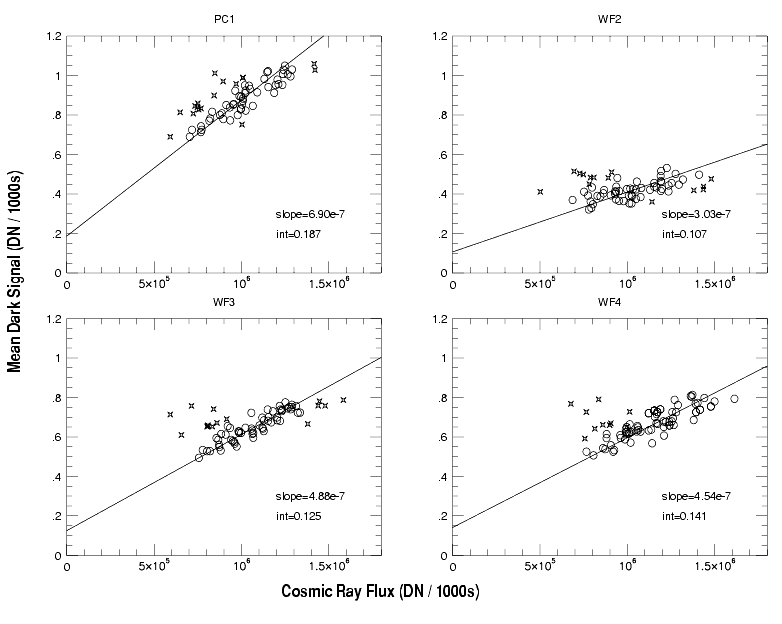



The dark current appears to have two components: one from electronic sources in the CCD, and a second component whose strength correlates with the cosmic ray flux. The electronic dark current is ~0.001 e- s-1, consistent with the Thermal Vacuum Test data.
The second component of dark current appears only on-orbit, its strength drops towards the edges of each CCD, and it is both chip- and time-dependent. At the current operating temperature, this non-electronic component constitutes up to 80% of the total signal measured in the PC. The fraction and overall level are lower in the other chips, and lowest in WF2. This second component ranges from 0.001 e- s-1 (WF2) to 0.005 e- s-1 (PC). The edge drop off is shown in Figure 4.5, where the average of lines 200-600 for each chip (with hot pixels rejected) is plotted in e- s-1 as a function of column number. The drop near the edge is consistent with luminescence from the CCD windows, shadowed by a field stop mask just in front of the CCD.
| CCD Temperature (°C) |
Dark count rate (e- s-1 pixel-1) |
| -20 |
10.0 |
| -30 |
3.0 |
| -40 |
1.0 |
| -50 |
0.3 |
| -70 |
0.03 |
| -77 |
0.016 |
| -83 |
0.008 |
| -88 |
0.0045 |
A further indication of the possible origin of this second component is the correlation between its amplitude and the cosmic ray activity in the same exposure, as shown in Figure 4.6. For example, the cosmic ray flux in the PC varies from 7x105 to 13x105 DN per 1000s, while the total dark signal in the PC varies concurrently between 0.0007 and 0.0010 DN s-1. Similar, though slightly smaller effects are seen in the WFC CCDs. These clues point to cosmic-ray induced scintillation of the MgF2 field-flattening windows as a likely source of the second dark current component. This might be caused by impurities in the MgF2 windows; if so, the window of WF2 must contain substantially less impurities. However, other explanations cannot be completely ruled out at this point.
Figure 4.6: Dark Signal vs. Cosmic Ray Flux. Slopes and intercepts ("int") are given on plots. Units are DN/1000s; 1 DN ~ 7 e-.
For the great majority of WFPC2 observations, this effect is negligible. In fact, it is noticeable mainly because the true dark rate is very low at the -88°C operating temperature. However, observations for which the dark current is an important limiting factor, either due to noise or background flatness, will require special handling to remove the signature of the dark current properly, as its amplitude depends on the time-variable cosmic ray flux.


|
Space Telescope Science Institute http://www.stsci.edu Voice: (410) 338-1082 help@stsci.edu |